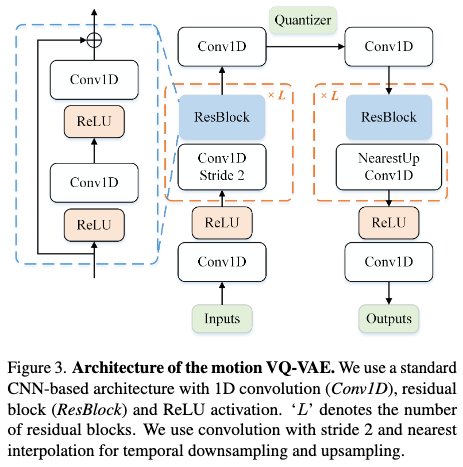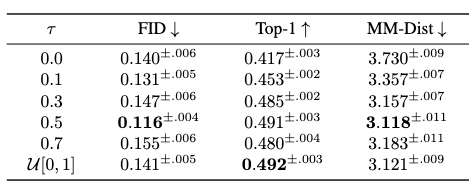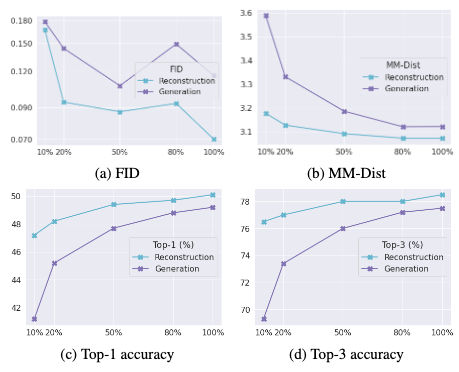Problem
How to generate a human motion sequence w.r.t. its textual descriptions?
Observations
- The choice of \(L_1\) smooth loss has significant impact for optimizing the motion reconstruction models used.
- Enforcing additional reconstruction on motion velocity during VQ-VAE training enhances generation quality.
- Naive training of VQ-VAE suffers from codebook collapse.
Assumptions
- Motion sequences can be well represented by discrete code sequences.
- Larger training data can lead to higher performance of T2M-GPT, i.e. the information contained in current datasets (HumanML3D and KIT-ML) are insufficient.
Contributions
- A motion generator based on the classic generative model: vector quantization variational autoencoder (VQ-VAE) and generative pretrained transformer (GPT).
- Superior performance of T2M-GPT questions the dominance of recent diffusion models for motion generation.
Pipeline

The model contains two modules:
- A VQ-VAE to map motion data to their discrete code representations.
- A T2M-GPT module to map text descriptions to discrete motion codes, which are then reconstructed by VQ-VAE to motion sequences.
VQ-VAE
A VQ-VAE learns discrete representations for generative models.
Given a motion sequence \(\mathbf{X} = [\mathbf{x}_1, \mathbf{x}_2, \cdots \mathbf{x}_T]\) where \(\mathbf{x}_i \in \mathbb{R}^d\) contains the \(d\) pose parameters for the \(i\)-th frame, the model first maps it to a sequence of latent features \(\mathbf{Z}=[\mathbf{z}_1, \mathbf{z}_2, \cdots, \mathbf{z}_{T/l}]\) through an encoder, where \(l\) is the downsampling rate of the encoder.
Next, \(\mathbf{Z}\) is passed through a quantizer which maintains a codebook of representative latent features \(C= \{ c_k \}^K_{k=1}\). We find the most similar features w.r.t. each code in \(\mathbf{Z}\):

Finally, the quantized code sequence \(\hat{\mathbf{Z}}\) is passed through a decoder to reconstruct the motion sequence. Notice that \(\hat{\mathbf{Z}}\) serves as our final representation for a motion sequence.
Training
The original VQ-VAE is trained mainly through three losses:
- A reconstruction loss, which is used to train the encoder and decoder.
- An embedding loss, which is used to update the codebook since the reconstruction loss doesn’t back-propagates to the codebook.
- A commitment loss, which serves as a regularization to encourage the encoder to commit to a particular code.
Together, these terms form the total loss:

where \(sg\) is the stop-gradient operator that keeps back-propagation updates out of its operand during optimization, by fixating the parameters of the operand.
Notice that in the original VQ-VAE paper, the authors found the training result quite insensitive to the hyperparameter \(\beta\).
The best codebook is found to have a capacity of 512 codes in ablation studies, which allows for the lowest FID and highest top-1 score in HumanML3D. This is intriguing since higher capacity actually lowers the performance, which suggests that the codebook can trigger overfitting/mode-collapse of the generative model.
Extra Regularization in Reconstruction Loss
By observations 1 and 2, the reconstruction loss is defined by two \(L_1\) smooth losses on the reconstructed static poses and frame-to-frame velocities, w.r.t. the original motion data:

The inclusion of velocity reconstruction is shown to enhance the reconstruction performance.
The balancing hyperparameter \(\alpha\) is shown to be best set as 0.5, and the model is quite sensitive to this hyperparameter. Setting it to 0 and 1 typically yields poorer performance in FID, but no significant change in top-1 score. However, when coupled with \(L_2\) loss a higher \(\alpha\) seems to provide better results.
Architecture

Simple 1D convolution blocks are utilized along with residual connections in the VQ-VAE’s architecture. Architectures based on transformer are not investigated in this research.
Codebook Collapse
A naive training of the VQ-VAE suffers from codebook collapse (observation 3). There are two common ways to alleviate this issue:
- Exponential Moving Average (EMA), which makes the codebook evolve exponentially as \(C^t \leftarrow \lambda C^{t-1} + (1-\lambda) C^t\).
- Code Reset, which finds inactive codes and reassigns them according to input data.
The best result is obtained by employing both remedies when optimizing the quantizer.
T2M-GPT
A T2M-GPT is used to predict a VQ-VAE codebook index sequence \(S=[s_1, s_2, \cdots, s_{T/l}, End]\) autoregressively as a next-token prediction task, with an additional \(End\) token to denote the stop of motion generation.
\(S\), projected back into latent code sequence \(\hat{\mathbf{Z}}\) by the codebook \(C\), is then fed to the VQ-VAE decoder to reconstruct the final motion sequence.
T2M-GPT acts as a head module on top of the CLIP GPT. It takes in the embeddings produced by CLIP from the text descriptions.
Causal Self-attention
The self-attention is computed as the causal self-attention:

where \(mask\) ensures that future information is not allowed to attend the calculation of current tokens, making the token-prediction task autoregressive during inference.
Corrupted Sequence for Training-testing Discrepancy
During training, the \(i-1\) codebook indices are always correct, i.e. proved by the reconstruction optimization from VQ-VAE and always excerpted from ground-truth motion codes. The \(i\)-th index is then predicted with these totally correct conditions.
During testing, however, we cannot guarantee that the previous conditions are correct, since they are all predicted in an autoregressive manner.
Therefore, to compensate for this discrepancy we employ a data-augmentation strategy by corrupting the training index sequence to be \(\tau \times 100\%\) of the ground-truth sequence. This has proven to be helpful in boosting test performance.
An ablation study of \(\tau\) is provided for the T2M-GPT’s test set performance on HumanML3D dataset:

where an ideal performance is shown to happen under the situation where \(\tau\) is kept as a constant 0.5 rate.
Training
A log-likelihood of generated data distribution is maximized w.r.t. the original motion data distribution:

where

and \(c\) is the text embedding from CLIP.
Extensions
Impact of Data Size on T2M-GPT
It is shown that T2M-GPT improves its performance with more training data utilized in the HumanML3D dataset:

However, we observe most of the curves to be exponential rather than linear, which suggests a potentially overly optimistic statement from the authors, which states that even more data would continue to boost the model’s performance significantly.
Comments